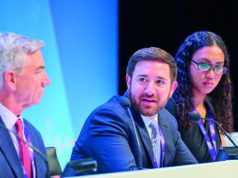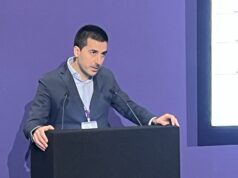
Studies have shown that robotic percutaneous coronary intervention (PCI) with the CorPath GRX System (Corindus, now part of Siemens Healthineers)—compared with manual PCI—reduces radiation exposure to the cath lab staff and may also improve precision. Furthermore, during the current pandemic, it potentially could help to reduce contact with COVID-19 patients undergoing PCI. Jon George (Einstein Medical Center, Philadelphia, USA), who recently performed robotic PCI on a suspected COVID patient, speaks to Cardiovascular News about the role of robotic PCI during a pandemic.
What is robotic PCI?
Ever since angioplasty emerged in the 1970s, we have been doing it the same way—an operator delivers a stent or balloon to a coronary artery via a catheter, which is inserted either through the groin or (as is more common these days) through the wrist. This involves, at least, the primary operator and their assistant being at the patient’s bedside at the site of access. However, over the last few years, we have seen the rapid evolution of robotic technology and now we have access to the CorPath system in which part of the procedure is supported by technology. The primary operator can now perform the procedure inside a cockpit or in the control room and be several feet away from the patient while the assistant can be at the foot of the bed much further from the access site.
What is the difference between robotic PCI and remote PCI?
Remote PCI is a different application of the system when the primary operator is not even in the same geographic location as the patient—they are only watching them through a live video screen.
In December 2018 in India, five remote PCI procedures were performed in which the operator was in a temple and the patients were in a hospital 32km away. In the USA, feasibility testing in porcine models, and transcontinental simulated telerobotic PCI procedures over various network types, including 5G, fiber, and public internet networks have all been completed. Of note, remote PCI does not have market approval in the USA or anywhere in the world. So, only feasibility studies have been performed.
Ultimately, robotic PCI is when you are close enough to have direct visualisation of the patient and system components remain hardwired, whereas remote PCI does not require the system to be hardwired, and the physician does not have direct physical visualisation of the patient. Instead, they use tools like a telecommunication system to see and communicate with patients and staff, despite the distance between them.

Generally, what are the potential benefits of robotic PCI?
The major benefit is that it reduces radiation exposure for the primary operator. The evolution of procedural techniques in the cath lab has led to staff being exposed to radiation during longer and more complex procedures. However, robotic PCI allows the primary operator to perform PCI from a lead-shielded cockpit, or from the control room. So, essentially, they go from having a fair amount of radiation exposure accumulate over multiple cases to very limited radiation exposure. Another member of the team does need to be at the patient’s bedside to load the balloon/stent onto the robotic arm of the system but they can do this from the foot of the bed and still be a relatively safe distance away as far as radiation is concerned.
A second benefit of doing procedures robotically is improved accuracy of the procedure, which has been established in literature. Potentially, the patient requires fewer stents to cover a blockage because the operator can be more precise robotically than with their bare hands, thereby using fewer stents where they are needed.
Could robotic PCI also help to reduce the level of exposure to patients with COVID-19?
That remains to be seen because that is a question that has not yet been explored. However, we do know that minimising contact with a COVID-19 patient—specifically, the source (i.e. the mouth) of potential viral particles—is what we should do to reduce the risk of exposure.
So if the patient’s mouth is covered and you are a good six feet or further away, in a cockpit or control room, then you are minimising exposure to the patient. Having said that, with the CorPath system, someone does need to be in the room to prep the patient and get all the equipment ready. So, that person will have some initial contact but, overall, robotic PCI could reduce the proximity to the patient for the bulk of the procedure. It means fewer staff members having less contact with the patient for majority of the procedure for those who do need to be at bedside.
How could remote PCI help?
That is the golden egg that we need to chase because remote PCI opens up all sorts of possibilities. Theoretically, you could have one operator at a non-COVID location remotely performing PCI in several COVID locations. Remote PCI could be a remarkable tool in a pandemic situation such as COVID-19 to further minimise the amount of person-to-person contact.
You have actually performed robotic PCI in a suspected COVID-19 patient. How did it go?
At the moment, the guideline is to use full personal protective equipment (PPE) for anyone coming into contact with a patient—so gloves, face shields, N95 masks, and gowns. We also preferentially perform procedures in negative pressure rooms to avoid viral particles dispersing outside of the room.
At our hospital, we performed robotic PCI in a suspected COVID-19 case to look at the feasibility of using the system in that scenario. We took all of the precautions; I was the main operator but I was also the person who was in the room, preparing the patient and the equipment. I had the remainder of my staff stand at the back of the room so they did not come into close contact with the patient. Therefore, I was the only one with any sort of direct exposure to the patient; at the same time, I was able to maintain a safe distance between myself and the patient’s mouth while going back and forth from the foot of the table to the cockpit. Had I not used robotic PCI, I would have been even closer to the patient. Furthermore, there probably would have been one or two additional staff members at the table, rather than just myself. So, the use of robotic PCI remarkably decreased the potential for exposure. However, this is anecdotal evidence and has not been evaluated in studies. We just know that we were able to do the one procedure with a single person going back and forth between the table and the cockpit.











